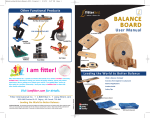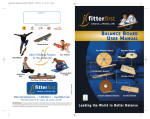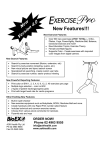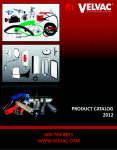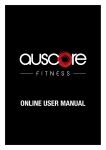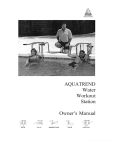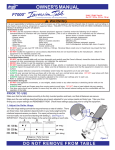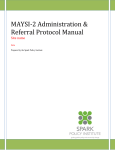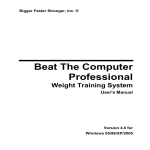Download BALANCE BOARD - Fitter Fitness
Transcript
Balance_Board_User_Manual_2011(3):Layout 1 4/30/13 10:35 AM Page 1 Other FUNctional Products BALANCE BOARD Pro Fitter 3D Cross Trainer User Manual Pro Wobble Board FOR YOUR ACTIVE LIFE! Duraball Pro Bongo Balance Board Bodyblade Swopper Rocker Board Combo Board Travel R oller Weeble Boards Leading the World to Better Balance What is Balance Training? Exercises from Beginner to Advanced Combobble Board Balance Applications Product Guide Safety Tips Fitter International Inc. • 1-800-fitter-1 • www.fitter1.com - Leading the World to Better Balance - Disclaimer/Warning - The products presented are designed to challenge and improve your balance skills. When using this equipment, you must accept full responsibility for the risk of injury to yourself and to others. Please read and fully understand all instructions before using these products. Remember, the best protection from injury is a little common sense! PRINTED IN CANADA 06/11 3050-2600 Portland St. SE Calgary, AB Canada T2G 4M6 Classic Balance Board Soft Board Advanced Soft Board Beginner Balance_Board_User_Manual_2011(3):Layout 1 4/30/13 10:35 AM Page 2 Balance Applications Rehab & Running 4 2 What is Balance Training? Product Guide Safe + Proper Use 9 6 Rocker Board Exercises Wobble Board Exercises Soft Board Exercises 10 “Among physical therapists and other sports-medicine specialists, the thought is, if athletes are using Balance Boards in certain ways, those techniques should also be good for patients who need to restore functional strength. So what's the bottom line? Balance Board training can dramatically improve the strength and coordination of all the key muscles involved in running. This should help you avoid injuries - and make you a considerably more powerful runner". Walt Reynolds, C.S.C.S. - Running Research News, December 1998 12 "It was almost 20 years ago that I purchased our first Pro Fitter from you to rehabilitate a player’s ankle. Since then, we have purchased another Pro Fitter and a large collection of your Balance Boards ... We have found your products to be high quality and something the players find fun, challenging and enjoy using. Thanks for helping to keep us healthy, strong and ready to play." Balance Applications Performance & Safety “Like anything else, balance is a skill”, said John Blievernicht, President of Sports Health C.A.R.E. Inc., a Chicago medical rehabilitation clinic. “And like any other skill, you’ve got to constantly practice it to preserve it ... After a while, (balance) exercises awaken reflexes and teach body awareness and control on a subconscious level. This can translate into lasting improvements in posture and overall quality of movement”, Mr. Blievernicht added, “regardless of age”. Liz Neporent, New York Times, January 1999 include Stability products in daily living, to improve Agility at play, and to maintain better Mobility for life. Athletic Training Jerry Attaway, Physical Development Coordinator, San Francisco Forty-Niners Football Club Weeble Board Exercises 11 10 Combo/Combobble Exercises 5 Athletic Training 14 Balance is a skill, and like any other skill, you’ve got to constantly practice it. Balance_Board_User_Manual_2011(3):Layout 1 13 Active Office - 4/30/13 10:35 AM Page 3 Balance Applications Active Standing At work or at home, stand on a Wobble Board while you’re talking on the phone or while taking a stretch break. You will quickly enjoy the benefits of stronger ankles and better balance. Revive Your 9 to 5... It is worth it to make your daily routine an asset to your long-term health! What is Balance Training? Balance Training Explained 2 Balance Training is the process of coaching our bodies and brains into gradually feeling comfortable with a full range of motion and stability activities. It demands physical and mental attention in order to create awareness of how the body moves in a variety of conditions. Our sense of proprioception can be trained to anticipate many different movements, so our bodies can react gracefully. An essential component of injury prevention, Balance Training is recommended for all ages. Ongoing Balance Training will keep our minds and bodies constantly aware of themselves, and functioning together. Fitterfirst has a variety of Balance Boards to suit your specific balance training needs. Louis Stack, President, Fitter International Inc. The Ideal Footrest When used as a footrest, an adjustable height Wobble Board allows dynamic movement of your legs and feet so they won’t get tired from being in the same position for hours. Footrest height should be set to allow your hips and knees to be at 900 angles. When Wobble Boards are combined with an Exercise Ball Chair or Active Disc, you will see improvements in balance, core stability and your overall relationship with gravity. At the Gym At the Office Benefits of Balance Board Training: Just for FUN Elite athletes depend on • Improved balance and coordination. Wobble Boards and • Better proprioceptive awareness Bongo Boards to train dynamic • Improved core stability & strength. balance. These highly effective • Increased leg strength. tools are fun to use and my • Greater ankle Range of Motion (R.O.M.) clients love them • Improved flexibility and agility. Keli Roberts, IDEA Fitness • Enhanced performance in sport and daily life. Instructor of the Year 2003 Balance_Board_User_Manual_2011(3):Layout 1 4/30/13 10:35 AM Page 4 3 What is Balance Training? Balance Applications - Age Gracefully: Improve Your Quality of Life! Falls and impaired mobility are a serious problem for the elderly. Approximately 1/3 of people over 65 experience a fall each year, with 1 in 20 falls resulting in serious injuries like hip, wrist or forearm fractures. The good news is that much of the decline in balance can be reversed through a program of balance training. One study found that healthy people as old as 90 years old can reduce the tendency to fall by 50% through balance training. It's not hard to see that this can help keep people independent and mobile far longer. Daily use of a Balance Board is an asset to your health and well-being. Much like brushing your teeth regularly, using a Balance Board is a simple exercise that will have a profound impact on your overall health. Regardless of your age or ability, Balance Boards can help you maintain a better relationship with gravity. Balance Training will let you experience ease of movement, and even improved posture. You feel more confident in your movements, whether climbing stairs or playing a sport. The more you use a Balance Board, the better your agility and reaction skills will become. Oh yeah, did we mention it’s fun? The Balance Game Daily opportunities to balance Sherri Kwasnicki, Fitness Columnist, The Province, Vancouver, BC Young or old, it’s never too late to start, and once you experience the benefits of it, you too will be hooked on the Balance Game for the rest of your life! • Balance on one foot while putting on your socks. For an added challenge, try closing your eyes. • Brush your teeth balancing on one leg. • Stand up and balance on one leg when on the phone. • Try sitting on a fitness ball instead of a chair. • Use a Wobble Board while doing dumbbell exercises. • Tight-rope walk along the edge of curbs. • Use the swings, slides and teeter totter in your local park • Play catch with a ball or Frisbee standing on one leg (do both sides). Louis Stack, President, Fitter International Inc. Active Aging 12 People as old as 90 years old can reduce the tendency to fall by 50% through balance training. Staying Upright in a Wobbly World A recent analysis of seven studies that focused on improving balance showed that people older than 60 who exercised regularly lowered their stumble risk by 13%. Those whose workouts included balance training lowered their risk by 25%. More recently, a study by Edward R. Laskowski, M.D., a physical medicine and rehabilitation specialist, showed the value of practicing on a Wobble Board... People in the study who used the Wobble Board for 15 minutes a day trained their ankle muscles to brace them in a way that would help protect them if they took a wrong step... Research is showing that movement is essential to retaining your health and vigor as you age. Doing exercise to build strength and enhance balance is an important complement to maintaining cardiovascular fitness through aerobic movement. Mayo Clinic Women's Health Source Balance_Board_User_Manual_2011(3):Layout 1 4/30/13 10:35 AM Page 5 11 Soft Board Exercises Product Beginner 16" Classic Balance Board Dual-Level 140, 170 Single Leg Squat • Place one foot in the centre of the Soft Board • Raise other knee up, while maintaining balance. • Do equal repetitions on both legs focusing on keeping your abdominals firm • Add light weights to increase challenge Balance Bridge • Place forearms on Soft Board, and extend legs behind you. • Keep body in a straight line, and hold. • Maneuver from side to side or front to back for an added challenge. Glute Raise • Laying flat on your back with both knees bent and feet on the Soft Board. • Extend one leg out straight • Raise hips as high as you can. • Keep core straight, by keeping knees, hips and head in a straight line. Soft Boards Experience The Sensation of Floating Beginner 16" Wobble Board Advanced Tri-Level 150, 170, 200 20" Wobble Board Intermediate Tri-Level 100, 120, 150 Intermediate Advanced Soft Boards are the newest innovation in balance training. A cushioned yet firm base makes the Soft Boards truly unique. With a distinct 3-D sensation they will help you easily and safely achieve better balance, coordination and overall agility. The Soft Boards gripped surface and non-slip legs provide a predictable foundation, so you feel safe while you engage your body. Made with a closed-cell durable foam which supports ease of movement and is gentle on your body. Intermediate Users 20" Rocker Board Single plane Beginner Tri-Level 100, 120, 150 Combobble Board Multi Angle Tri-Level Applications General public. Children. Office workers. Group fitness classes. • • • • Early-Late rehabilitation Balance training. As a footrest. Active standing. • • • Beginners. Seniors. Intermediate level users. • • • • Early-Late rehabilitation Home. Gym. Office. • Seniors. • Injured rehabilitation patients. • Athletes. • • • • Early-Late rehabilitation Home.& Gym. Dynamic training. Squat training. • Advanced users. • Athletes. • Home. • Gym. • Intermediate to Advanced users. • Athletes. • • • • • • • • General public. Children. Advanced users. Athletes. • • • • Late rehabilitation Home. Gym. Office. • All users. Combo Board • Beginner to Intermediate users. • Seniors. • Equestrian riders. Soft Boards • Beginner to Intermediate users. • Seniors. 4 Leg (Beginner) 1 Roller (Int.) 1 Leg (advanced) Advanced • • • • WobbleBoard Stand 11" Weeble Boards Single Level 180 Fitterfirst Soft Boards Product Guide Rehabilitation. Home. Gym. Squat training. • Rehabilitation. • Home. • Gym. • Rehabilitation. • Home. • Gym. 4 Balance_Board_User_Manual_2011(3):Layout 1 5 4/30/13 10:35 AM Safe & Proper Use D u a l- Le ve l D esi g n Classic 1. Lift, turn counter clockwise until click. 2. Release. 140 or 170 1 Page 6 Weeble Board Exercises 10 2 T r i - L e v e l D e s i g n PROFESSIONAL 1. Spin left to loosen. 2. Spin up or down to desired level. 3. Spin sphere & spacer together to the right to tighten for use. 20’’- Intermediate 100, 120, 150 16’’ - Advanced 150, 170, 200 Weighted Squat USA Patent No. 5,810,703 • Perform a squat while attempting to keep the edges of the Boards from touching the floor. Step Safely - Take These Safety Steps 1. Adjust Wobble Boards to the lowest possible setting for first time use. 2. Only use these products on a dry surface free of any obstacles. 3. You may need to step off quickly- make sure you have ample space 4. If you feel unsafe or feel like you may fall: - Step off the Board. Do not use again until you have the help of a spotter or some other Lunges • Begin with your front foot on a single Weeble Board. • Lunge forward until your front knee reaches 90º. • Add weights to increase challenge. Push Ups • Start with wrists centered on each Board. • Use caution - wrists must be in full flexion position. • Try different width and staggered board positions. • Try one foot to increase challenge. Combo & Combobble Exercises suitable form of balance aid. - Stand in a doorway and touch both sides of the door frame beside you. Always maintain proper upright posture with your head up, back straight and knees bent. Keep your eyes focused straight ahead. Do not stare down at the ground or at your feet as this may lead to loss of balance. If used properly, Wobble and Rocker Boards are fun and FUNctional training tools. The basic idea is to move the Board in a controlled manner in all directions. It is more important to maintain correct posture than it is to successfully complete these exercises. With practice you will be able to do these exercises and maintain a proper heads-up posture. The exercises on the following pages outline the basic activities you can do on these Boards. Basic Exercises: • Rock back and forth or from side-to-side. • Change the fulcrum as ability progresses. • Experiment with different foot positions for an added challenge. Beginner Advanced Exercises: • Using a wider stance, attempt full squats. • Close your eyes, always use a spotter when you first try this. • Always USE YOUR BALANCE BOARD with caution. Intermediate Advanced Balance_Board_User_Manual_2011(3):Layout 1 9 4/30/13 10:35 AM Page 7 Rocker Board Exercises Intermediate Basic Wobble Board Exercises Rehabilitation 6 Basic Begin with a gentle Range of Motion (R.O.M.) on the Wobble Board until you become familiar with the movement. Exercises such as side-to-side, front-to-back, and circular rotation are all excellent basic exercises to start with. ain int ody TsIP a m tb ay righ d Alwle up on ans-up s b d ti sta posi r hea th eyet i pe w igh prosture stra po oking ead lo ah Front to Back Side to Side Front to Back With your feet planted squarely on the Wobble Board, begin a slow controlled movement from side-to-side without the front or back touching the floor. Slowly, and in a controlled manner, move the Board from toe to heel. Rotation Calf Stretch Side to Side Position your feet shoulderwidth apart, centrally on the Board. Begin by slowly moving the Board side-toside, or front-to-back with a controlled movement. Tri-level design allows user to adjust the single plane tilt from 100, 120 and 150 . This varies the Board’s degree of difficulty. Beginner • Try adding in other exercises while attempting to maintain control. Some suggestions are squats, lunges, push-ups and ball tossing/bouncing. • Incorporate other equipment such as a Bodyblade™. • Advanced users may attempt these exercises on one foot for greater challenge. Intermediate • By rotating your stance on the Rocker Board, you can gently increase your ankle's R.O.M. • Helps to restore stability. Remember - only you and your Medical Professional will know what is best for you! Advanced Balance Aids can be used by individuals with limited balance and during early rehabilitation for additional support. Beginner • Rotate the Wobble Board using a controlled circular motion. • Remain balanced on the sphere without the sides touching the floor. Intermediate • Keep the heel of your back leg on the floor and lean forward until you feel a stretch. • Effectively stretches the calf (gastrocnemius & soleus). Advanced Balance_Board_User_Manual_2011(3):Layout 1 7 4/30/13 10:35 AM Page 8 Wobble Board Exercises Intermediate Balanced Push-ups Wobble Board Exercises 8 Advanced Ab Training Kneeling Exercises Motor Skill Training • Start on your knees and work up to full push-ups as you become comfortable with the challenge. • Use caution and be aware that the wrists are in a full flexion position for this activity. • Ensure that your hands stay on top of the Board or else your fingers might get pinched! • Improves core stability. • While seated on the Board maintain proper posture while using your trunk muscles to begin a slow rotational movement. • If you have ever had back problems, consult with a physician before doing these activities. • Improves core strength, R.O.M.and mobility in the lower back and trunk. • Kneel on the Board with your hands on your hips, or by your side. • Use your trunk muscles to begin a slow rotational movement. • After several rotations, stop and rotate the Board in the opposite direction. • Increases R.O.M. and stability of the trunk and pelvic areas. • Perform any of the previous exercises while bouncing or throwing a ball or doing some other dynamic activity. • Enhances hand-eye coordination and subconscious reaction. • Your conscious mind focuses on one activity while your subconscious mind is working on ankle R.O.M. and overall stability. Variation Variation Variation Variation One Leg Exercises • Perform the basic moves while balancing on one leg. • Position your foot arch directly over the center of the Board, so that you can comfortably move the Board in any direction. • Exercises require more strength and stability and you may feel that one leg is much stronger than the other. Variation Eyes Closed • This is the most difficult way to use Wobble and Rocker Boards. • Always start the exercise with your eyes open. When you and your spotter are ready, close your eyes only until you feel off balance. • Enhances proprioceptive response and reaction time. • Only attempt when you have achieved an advanced level of stability and balance. W a r n i n g : This activity is risky and falls should be expected. Perform with a spotter. Beginner Intermediate Advanced Beginner Intermediate Advanced








